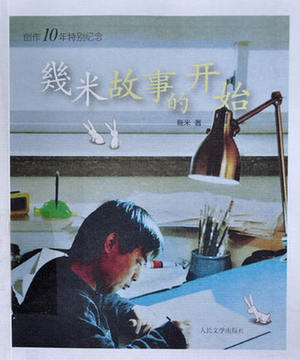Painting for His Life
Painting for His Life
The Beginning of the Story of Jimmy Liao
By staff reporter LIU YI
The Beginning of the Story of Jimmy Liao By Jimmy Liao 211 pages, RMB 48 Published in Beijing by The People's Literature Publishing House in 2010

JIMMY Liao is undoubtedly one of the hottest illustrators in Chinese publishing circles. The Taiwanese artist has published 17 popular books so far, and they have been translated into English, French, German, Greek, Japanese, Korean and other languages. It seems difficult to define his literary genre; imaginative and a riot of color, they are often called children’s books; however, the readers are usually adults living in urban centers the world over.
The answer probably lies in The Beginning of the Story of Jimmy Liao. This book tells the story behind his work – a journey of looking for the soul of life and purpose. Many pages of his published books have been reproduced therein, allowing readers a clear view of his creative process. Before publishing his first book in 1998 as he was transiting to his 40s, Jimmy worked with an advertising company and did some illustrations for newspapers part time. “Life used to be carefree, everything was taken for granted,” he writes, then one day in 1995 he was found to have leukemia.
For a whole year, he essentially lived in one room enduring endless examinations and treatments. Fever, vomiting, pain and faintness, along with crying, tears and the fear of death, occupied his waking life. However the desire to live made Jimmy more sensitive to everything around him. “Each cell of my body seemed open to receive the information emitted by the city from every direction.” He picked up his tools and painted while he clung to his hope for life.
The book that resulted is attracting real attention in the market. A Fish That Smiled at Me is his second book, completed in 1998. A middle-aged guy repeats his life day after day, numb to either joy or sorrow, until a smiling fish breaks his routine. The book resonates greatly with readers. Every office worker passing their grey days in the city dreams of finding his or her “fish.”
Its unexpected popularity in the market didn’t relieve Jimmy’s anxiety or struggles. Doctors told him he might have only five years left. Unpredictable and inconstant fate became his theme, driving such works as Turn Left, Turn Right (1999), one of his most popular books. The hero and heroine fall in love at a chance encounter, but the good time ends in a rain storm. They lose each other, search for each other, but all attempts fail. They never find out they actually live in the same apartment building, and never meet in its halls as one is used to turning left, and the other turning right.
This was the book in which Jimmy began to show proficiency in character development. Everyone’s life is rich – in feelings, habits and troubles of many kinds. Jimmy sees his books as a stage for his heroes and heroines, allowing them to perform their own stories. Some characters with minor roles in earlier books became the protagonists of his later books.
“In the beginning, I didn’t invest much emotion in any of my ‘little men.’ They were only tools to make money.” Jimmy confesses that in his earlier approaches to his work he reminded himself of a ruthless animal trainer. After recovering from cancer, he learnt to be grateful for everything, including his “little men.” He tries to blend his own narrative and feelings into his stories. “Sorrow, sadness and many feelings that can’t be spoken of are channeled through my creations.”
From the collective of illustrations for The Beginning of the Story of Jimmy Liao, we can tell clearly the evolving states of Jimmy’s mind. In the first few years, he seemingly preferred to work with simple lines in black-and-white. Turn Left, Turn Right signaled a big change – though it’s a tragedy, Jimmy applied a lot of warm tones in red and yellow. By now, his improved health, good feedback from readers, and in particular, his newborn daughter, were making him more confident about his life as well as his work. Jimmy’s unerring use of color was being fully showcased by the time Sound of Colors (2001) was produced. The palette in later books became even more vivid and passionate to express his imagination as in The Blue Stone (2006).
Here is a children’s writer, some people mistakenly think when glancing at the visual playfulness of his works. But slipping into the narrative of The Beginning of the Story of Jimmy Liao, you soon open up to all he has to tell – about hope, gratitude, and enthusiasm for life.
Services
Economy
- Eco-agriculture and Eco-tourism Power Nanchang’s Green Development
- Balance Environmental Protection and Economic Prosperity – Nanchang Looks to European Technology for Green Development
- Sustainable Growth Requires Wiser Energy Use
- Chinese Economy: On the Path of Scientific Development
- China's Economy over the Last Ten Years

